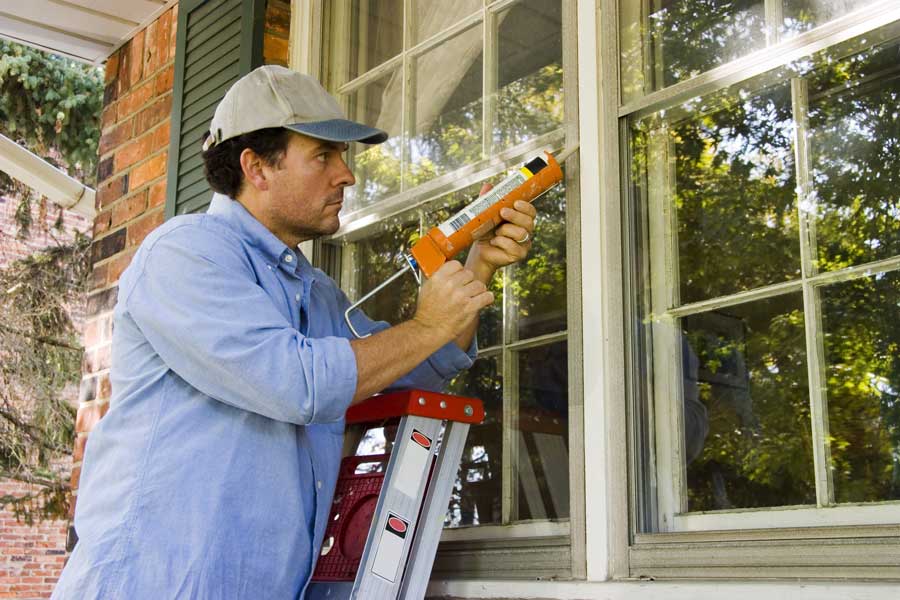Blog
Avoid These Window Caulking Mistakes
Window caulk is one of the cheapest and easiest ways to insulate your home more efficiently. However, it's also easy to make mistakes when applying it which can lead to lower energy efficiency, water damage, or mold growth. Here are some common mistakes homeowners make when caulking their windows and how to avoid them.
Consider Moving Components
The mistake: Applying caulk around the outside of windows without considering moving components.
The solution: Before caulking, move window screens and any hardware that might get in the way. If your window screen is too tight for you to slide it by hand, there are several ways you can adjust it, so it moves freely when open or closed. For storm windows, move the screen track to the top position if possible. Avoid applying caulk around any of these components since doing so can result in an uneven seal or a poor fit.
Weep Holes Should Be Avoided
The mistake: Caulking around the weep hole.
The solution: Weep holes are openings in your window frame that allow water to escape when the weather is humid or wet, but they also let air into your home. If you caulk over them, you'll trap moisture inside the wall cavity and wind up with moisture damage. Not all windows have weep holes but see if yours do before beginning to avoid filling them.
Pay attention to the interior and exterior of the window
The mistake: Applying the caulk on only one side of the window.
The solution: You need to apply caulk on both sides of the window. It's essential to do this if you notice any drafts coming through your windows, like a door on the other side. Keeping air out can keep your energy bills lower, so don't forget to caulk the interior as well as the exterior.
Use the Appropriate Caulk
The mistake: Using the wrong type of caulk for your window.
The solution: In general, you should be using silicone or urethane caulk rather than latex because they stretch more and don't break down in sunlight. However, this isn't a hard rule. Latex can work if it is specifically designed for outdoors, but you can't use it in a bathroom.​
Weather-resistant caulk is even better; it may cost a little more, but the extra few bucks will be worth it for the exterior when you don't have to redo your work. The best caulk for the interior is one that's easy to clean and paintable, so you won't have to worry about it when it comes time to put up new wallpaper or repaint.
In conclusion, following these simple steps will help you apply caulk to your windows with fewer mistakes. If you're interested in homes that are built to deliver lower energy bills, contact Goodwyn Building today! We would love to show you some of our homes and explain why we are the leading builder of energy efficient homes in Alabama!
By Goodwyn Building 11-23-2021
Recent:
Categories
Archive
Dec 2025
Nov 2025
Oct 2025
Sep 2025
Aug 2025
Jul 2025
Jun 2025
May 2025
Apr 2025
Mar 2025
Feb 2025
Jan 2025
Dec 2024
Nov 2024
Oct 2024
Sep 2024
Aug 2024
Jul 2024
May 2024
Apr 2024
Mar 2024
Feb 2024
Jan 2024
Dec 2023
Nov 2023
Oct 2023
Sep 2023
Aug 2023
Jul 2023
Jun 2023
May 2023
Apr 2023
Mar 2023
Feb 2023
Jan 2023
Dec 2022
Nov 2022
Oct 2022
Sep 2022
Aug 2022
Jul 2022
Jun 2022
May 2022
Apr 2022
Mar 2022
Feb 2022
Jan 2022
Dec 2021
Nov 2021
Oct 2021
Sep 2021
Aug 2021
Jul 2021
Jun 2021
May 2021
Apr 2021
Mar 2021
Feb 2021
Jan 2021
Dec 2020
Nov 2020
Oct 2020
Sep 2020
Aug 2020
Jul 2020
Jun 2020
May 2020
Apr 2020
Mar 2020
Feb 2020
Jan 2020
Dec 2019
Nov 2019
Sep 2019
Aug 2019
Jun 2019
May 2019
Apr 2019
Jan 2019
Nov 2018
Sep 2018
Aug 2018
Jun 2018
Jan 2018
Nov 2017
Oct 2017
Jun 2017
May 2017
Jan 2017
Aug 2016
May 2016
